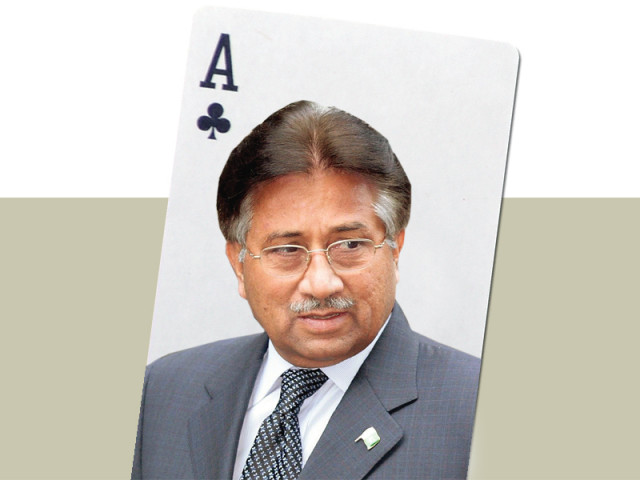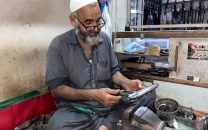Bridge, anyone?
Tahir Masood explains bridge and talks about the decline of the game in Pakistan.

“It is one of the most sophisticated card games,” explains retired banker MAJ who played between 1975 and 1981 until his bridge partner left for Canada. “It’s about the application of the mind, the fact that not everyone can play it.”
It was considered such a good exercise that officers encouraged their men to play it in the Pakistan Army. That was before cell phones and the internet. “Our superiors thought that it was the best way to groom our young minds,” says Col (retd) Basharat Ali, who played many a game in the mess.
The technicality of bridge puts off many people who would rather play simpler games like rummy. But as fans will tell you, if you manage to get a seat at the table, it is an addictive and elegant game. In fact, the best players are even able to visualise their opponents’ hands after just a few cards have been played.
Aside from grey cells, all you need to get started is a standard deck of 52 cards dealt equally among four players. The players try to make as many ‘tricks’ as they can. (A trick is just a collection of four cards, one contributed by each player.) There are 685 billion possible hands you can play.
History of bridge
Bridge traces its origins to the British game of Whist, locally known as Court Piece, or Saath Haath, first played in the 16th century. According to one etymological theory, the game may have been named after the Galata Bridge in Constantinople, which British soldiers crossed during the Crimean War of the 19th century, to reach a coffeehouse where they played cards.
In 1925, Harold S Vanderbilt, America’s richest man at the time, took a cruise on the SS Finland with three fellow auction bridge enthusiasts. It was there that Vanderbilt invented what we now call contract bridge, by coming up with a structured set of rules, principles, treatments and an extraordinary scoring system.
Tournament bridge started in Pakistan in the mid 1970s. “A gentleman by the name of Dr Muhammad Ilyas moved back to Karachi from Saudi Arabia and started conducting bridge clubs,” says Tahir Masood. Masood is one of the top players in the country. In addition to having written a book on the subject, he regularly teaches the game at T2F. He also manages the Bridge Federation and has been a member of the Pakistan National Bridge Team on and off for more than three decades, representing Pakistan in umpteen international events.

Ilyas opened the first bridge club at Bangalore Town Hall off Tipu Sultan Road in Karachi. In mid-1977, however, the club was forced to vacate the premises as an adjoining mosque accused them of gambling. The club managed to acquire a space underneath one of the cricketing stands at the National Stadium where it is located to this day.
After Dr Ilyas introduced bridge, a man named M. Aslam Sheikh dedicated his life to promoting the game. He used to conduct twice-a-week sessions at the stadium where all the top players used to go. New talent thus emerged in the early 1980s and Masood was part of the new breed of players. They were nurtured by none other than Zia Mahmood. It certainly helped the prestige of the game that in 1981 he led the Pakistani team into the finals in the Bermuda Bowl.
Pakistan did reasonably well in competitions abroad, until players started growing old, some stopped playing and others left the country. In 1995, the man who had done much to bring people to the table, M Aslam Sheikh, was killed during an armed robbery at home.
“That was a sad end to the promotion of duplicate bridge in Pakistan,” says Masood. Sheikh had, after all, dedicated his life to the game; he would get sponsors, organise tournaments and he even introduced a master point system in which players could work towards the highest rank of life master.
After Sheikh’s death, interest in bridge waned. Zia Mahmood also left the country. In fact, strangely enough, emigration became a major factor behind the decline in the game.
Bridge requires two sets of partners and these relationships tend to become larger than life. Thus, when your partner leaves, as MAJ’s did for Canada, you tend to stop playing. “When our group split, it was hard to make another group,” says the retired banker. “Either you make your own group [by finding three more players] or you find a group with a gap.” Neither option is easy. It was for many people just easier to start playing other games such as rummy which can accommodate even or odd numbers of players.
Banker Muhammad Munir Hussain, who learnt the game from his older brother and was at one point “obsessed”, hasn’t played for over 30 years. “Back then, it was all the rage,” he recalls. “Now I hardly find the time, more importantly it is even harder finding three other players.”
Bridge may be too old school for the generation that is more interested in its version of poker games and Texas hold ’em. This may explain why bridge die-hards Bill Gates and Warren Buffet have said they are willing to put a million dollars into reviving the game in high schools across America. In Pakistan also, this may be fertile ground. For example, Dosti Zahra Jafri, an undergraduate student today, started playing the game at Karachi’s L’ecole. In 2008, she was on the under-28 Pakistan team that went to the 13th World Bridge Games in Beijing. According to her, there are a lot of young people playing in the country. They just need a little support and encouragement. Perhaps the government needs to lend a hand.
Contract Bridge Terminology
Auction
See bidding.
Auction Bridge
An earlier form of bridge, replaced by contract bridge owing to changes in scoring methods
Bidding
The first stage of a deal when players jointly determine the final contract. Having examined their own cards, they make a series of calls in rotation, which is called the auction or the bidding
Contract
The statement of the pair who has won the bidding, that they will take at least the given number of tricks. The contract consists of two components: the level, stating the number of tricks to be taken. The last bid in the bidding phase denotes the final contract.
Short for contract bridge in contrast to auction bridge (auction) and other card games in the family
Duplicate bridge
A form of bridge in which every deal is played at several tables, by several pairs, and their scores on each deal are subsequently compared. A minimum of two tables (four pairs) are required for a duplicate bridge event. Each entry might be a pair, or a team consisting of two or more pairs — the type of scoring varies accordingly. The hands of each deal are kept in metal or plastic containers called boards that are passed between tables
Rubber bridge
The original form of contract bridge, a contest with four players in two opposing pairs (as distinct from duplicate bridge, which requires a minimum of eight players)
Trump
A card in the trump suit whose trick-taking power is greater than any plain suit card let us give you a hand How to play Minibridge:
Minibridge is a simplified form of contract bridge designed to expose newcomers to the game without the burden of learning a detailed bridge bidding system.
This is a variant of Minibridge. It is played with a standard pack of 52 playing cards with the jokers removed. There are four players, who sit round a table and are usually identified by the points of the compass: North, South, East and West. They play as two partnerships, North-South and East-West.
Let us give you a hand
Step 1: Deal

Choose a “dealer”, or the person who will pass out the cards. Separate the Ace, King, Queen and Jack of a suit. Shuffle them and distribute them in a clockwise direction. The person with the Ace will be the dealer.
Deal the hand: This is done by passing one card to each player in clockwise rotation, face down, around the table until each player has 13 cards, and all the cards are passed out.
Step 2: Sort

Sort your hand. Each player will sort their cards according to “suit”, that is, spades, hearts, diamonds, and clubs, with the cards of each suit placed in descending order, from the ace down to the deuce (2).
Step 3: Count

Calculate the points in each hand. The number cards do not have any points, while each face card has an assigned point value. The Ace is 4 points, the King is 3 points, the Queen is 2 points and the Jack is 1 point.
For example: if you have 2Q 1K 2A 1J = 16 points
After each player calculates their points, the dealer starts by telling everyone how many points they have, then in a clockwise direction everyone else states their points.
The team with the majority points (both their points added up) will be the attackers and the team with the lowest points will be the defenders.
The attackers will then decide how many tricks they want to make. They can make anywhere between seven to 13 tricks. The goal of the defenders is to stop them from making the tricks.
The attacking team then decides which of them will be the ‘Boss’ and which will be the ‘Puppet’. The Puppet is a passive player who has to follow the lead of the Boss.
Step 4: Play

After the Boss and Puppet have been decided, the person on the left of the Boss starts by ‘leading’ or playing the first card to a trick. The Puppet then lays their card face up on the table for all to see. Remember, the Puppet is a passive player and all the moves must be directed by the Boss.
Each player in turn clockwise will contribute one card to each trick and the highest card played wins the trick. Aces are high, followed in order by the King, Queen, Jack, ten, nine and so on down to the two, the lowest card in each suit. When playing to a trick, each player must ‘follow suit’ with a card of the suit led if possible.
Otherwise they may discard any card they like, but a discard cannot win the trick, however high the card chosen. The winner of a trick makes the lead to the next trick
At the end of the game the attackers count their tricks and if they have made the number of tricks they declared, they win the game
Pakistan’s Zia Mahmood — the world champion

Zia Mahmood is to bridge what Muhammad Ali was to boxing, what Bobby Fisher was to chess and what Tiger Woods is to golf.
With his charismatic personality, signature black-rimmed spectacles and flamboyant playing style, he is the most popular player in the world right now and has been for the last 20 years.
Zia is a Pakistani professional bridge player. He is a World Bridge Federation and American Contract Bridge League Grand Life Master and is considered to be one of the greatest players of the game. Zia achieved international bridge fame practically overnight when he led Pakistan to second place in the 1981 Bermuda Bowl tournament.
He was born in Karachi and was educated in England from the age of six to 21. He qualified as a Chartered Accountant of the Institute of England and Wales and spent three years running the family newspaper chain in Pakistan. Zia’s introduction to bridge actually began because of a girl. “She was only allowed to attend bridge parties, so I lied and said I played,” Zia once admitted in an interview. “Over the course of the next two weeks playing bridge and meeting her, I fell more in love with the game than with her.”
After winning silver at the Bermuda Bowl, Zia did nothing but play bridge. When he couldn’t find like-minded players, he started playing bridge in the UK. He went on to become the World Bridge Champion while playing for America. He now spends much of his time in Great Britain and the United States, where he lives with his wife and two sons.
It is a measure of his fame that in 1997, Phillip and Robert King published a collection of short stories titled Your Deal, Mr. Bond. In one of the stories, 007’s boss M assigns James Bond the task of defeating the bridge-playing villain Saladin who threatens to set off nuclear bombs. Bond impersonates none other than Zia Mahmood in order to beat the villain at the table.
How to get in on the game
All the major clubs have card rooms where rubber bridge can be played.
For duplicate bridge
Karachi Bridge Association
www.pbf-bridge.com
The KBA hosts weekly duplicate bridge games at the Aslam Bridge Hall
Lahore Gymkhana
Upper Shahrah-e-Quaid-e-Azam. Ph: 111 111 231, 35756690-95
www.lahoregymkhana.com.pk
The Gymkhana hosts a number of duplicate bridge
tournaments
Islamabad Club
Main Murree Road
Ph: 051-9046191
www.islamabadclub.org.pk
The club hosts daily duplicate bridge games.
T2F, Karachi
10-C, Sunset Lane 5, Phase 2 Extension, DHA, Karachi
Ph: 021 3538-9043 www.t2f.biz T2F hosts regular bridge classes with Tahir Masood
Published in The Express Tribune, Sunday Magazine, April 7th, 2013.
Like Express Tribune Magazine on Facebook to stay informed and join the conversation.



















COMMENTS
Comments are moderated and generally will be posted if they are on-topic and not abusive.
For more information, please see our Comments FAQ